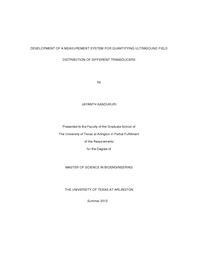
ATTENTION: The works hosted here are being migrated to a new repository that will consolidate resources, improve discoverability, and better show UTA's research impact on the global community. We will update authors as the migration progresses. Please see MavMatrix for more information.
Show simple item record
| dc.contributor.author | Kandukuri, Jayanth | en_US |
| dc.date.accessioned | 2014-03-10T21:17:40Z | |
| dc.date.available | 2014-03-10T21:17:40Z | |
| dc.date.issued | 2014-03-10 | |
| dc.date.submitted | January 2012 | en_US |
| dc.identifier.other | DISS-11839 | en_US |
| dc.identifier.uri | http://hdl.handle.net/10106/24053 | |
| dc.description.abstract | Ultrasound has been widely used in many fields, such as nondestructive examination and medical imaging. Ultrasound is mostly characterized by its pressure and, dynamic pressure wave can be considered to be the foundation of ultrasound physics and imaging techniques. It is thus important for understanding ultrasound pressure properties to that of ultrasound intensity. Moreover, there are many applications that require mainly characterizing ultrasound pressure field (instead of intensity field alone). Therefore, reconstruction of an ultrasound pressure field is highly desirable not only for education but also for research. There may be some commercially available systems that can be used for 2- or 3-D reconstruction of an ultrasound pressure field based on a needle-shaped hydrophone such as AIMS system from Onda Inc. However, they are usually very expensive (>tens of thousands US dollars) and unaffordable for many educators, professionals and researchers (even for those researchers whose main research streams are not ultrasound but need to measure a dynamic pressure field for some reasons). However, they are usually very expensive (>tens of thousands US dollars) and unaffordable for many educators, professionals and researchers (even for those researchers whose main research streams are not ultrasound but need to measure a dynamic pressure field for some reasons). In addition, this system can be used to conduct VI ultrasound imaging, and study microbubble-enhanced ultrasound imaging. Although the principle of the developed system is straightforward, engineering challenges exist in the development of both hardware and software. Therefore, we would like to share our design, experience and results to the community to make the system affordable and provide multi-functional system for research and education. Second part of study focuses around understanding the working of High intensity focused ultrasound (HIFU) that is used for delivering high pressure thereby increaseing the localize temperature. Many investigations have been conducted in the past to understand thermal effects of HIFU procedures using many thermal sensitive sensors which are used to characterize the temperature distribution at its focus. The most prominent and reliable was the measurement obtained using fine wire thermocouple. In our study we aim at using very short duration excitation of HIFU and study the thermal distribution by varying combination of both power and duration of each burst using one such fine wire thermocouple. We were also able to verify the focal size and focal volume of the HIFU. Cavitation and viscous heating artifacts that predominantly affect the long duration HIFU investigations have been shown to be absent. Results and discussions have been presented to support our hypothesis. | en_US |
| dc.description.sponsorship | Yuan, Baohong | en_US |
| dc.language.iso | en | en_US |
| dc.publisher | Biomedical Engineering | en_US |
| dc.title | Development Of A Measurement System For Quantifying Ultrasound Field Distribution Of Different Transducers | en_US |
| dc.type | M.S. | en_US |
| dc.contributor.committeeChair | Yuan, Baohong | en_US |
| dc.degree.department | Biomedical Engineering | en_US |
| dc.degree.discipline | Biomedical Engineering | en_US |
| dc.degree.grantor | University of Texas at Arlington | en_US |
| dc.degree.level | masters | en_US |
| dc.degree.name | M.S. | en_US |
Files in this item
- Name:
- Kandukuri_uta_2502M_11839.pdf
- Size:
- 2.310Mb
- Format:
- PDF
- Name:
- Video-1-1MHz_hydrophone.mp4
- Size:
- 1.015Mb
- Format:
- Unknown
- Name:
- Video-2-1MHz_wire.mp4
- Size:
- 849.7Kb
- Format:
- Unknown
- Name:
- Video-3(a)-2_25MHz_wire.mp4
- Size:
- 1.340Mb
- Format:
- Unknown
- Name:
- Video-3(b)-5MHz_wire.mp4
- Size:
- 1.630Mb
- Format:
- Unknown
- Name:
- Video-4-2_25MHz_interference.mp4
- Size:
- 1.040Mb
- Format:
- Unknown
- Name:
- Video-5-2_25MHz_interference_1 ...
- Size:
- 1.158Mb
- Format:
- Unknown
- Name:
- Video-6-2_25MHz_interference_2 ...
- Size:
- 1.164Mb
- Format:
- Unknown
- Name:
- Video-7-XZ-7_5MHz.mp4
- Size:
- 771.8Kb
- Format:
- Unknown
- Name:
- Video-8-XY-7_5MHz.mp4
- Size:
- 720.4Kb
- Format:
- Unknown
- Name:
- Video-9-XY-2_5MHz.mp4
- Size:
- 4.322Mb
- Format:
- Unknown
- Name:
- Video-10-XZ-2_5MHz.mp4
- Size:
- 2.021Mb
- Format:
- Unknown
This item appears in the following Collection(s)
Show simple item record


